Selling your art to hotels and businesses can be a lucrative endeavor. I recently had the opportunity to display my work in a boutique hotel, and the experience was both rewarding and profitable.
But how exactly does one go about approaching these establishments and securing a deal? Well, it all starts with understanding the specific needs and preferences of the hospitality and corporate art market. It’s not just about creating art; it’s about understanding the business behind it.
So, let’s dive into the art of selling art to hotels and businesses and explore the strategies that can help you succeed in this niche market.
Key Takeaways
- Stay informed about industry trends and develop a professional portfolio to reflect the diverse needs of potential clients.
- Research and analyze specific needs and preferences of target businesses and hotels, and tailor art to their specific requirements.
- Build relationships with decision-makers by targeting specific design firms and art consultants, utilizing social media, and attending industry events.
- Ensure that your art aligns with the overall aesthetic and branding of the establishment, and consider durability to withstand heavy foot traffic.
Understanding the Hospitality and Corporate Art Market
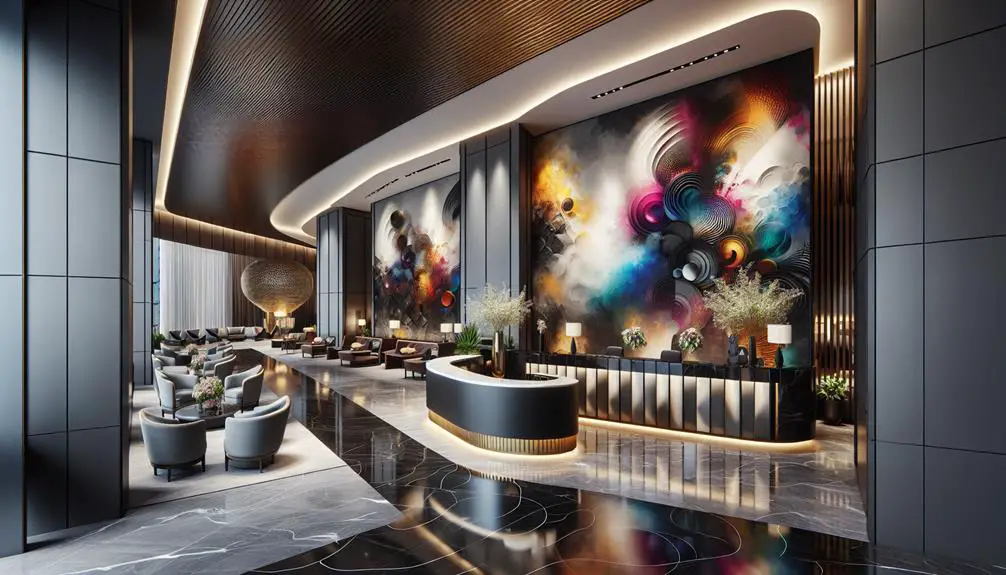
Understanding the hospitality and corporate art market involves staying informed about the latest industry trends and developing a professional portfolio to connect with potential buyers.
As an artist, it’s crucial to recognize that buyers in the hospitality industry, including hotels and casinos, often seek to revamp their spaces to maintain a fresh and appealing aesthetic. Artwork needed in this industry typically includes reproductions and prints, with images licensed for print production.
To effectively connect with buyers in the hospitality sector, I actively keep abreast of industry trends and ensure that my portfolio reflects the diverse needs of potential clients. Additionally, presenting and marketing artwork to hospitality buyers demands a highly professional approach, along with a profound understanding of the unique needs and challenges of the clients.
Exploring alternative sales channels, such as retailing artwork live or online and taking commissions for custom pieces, can open up new opportunities for artists looking to tap into the hospitality market. By staying innovative and adaptable, I can position myself to thrive in this dynamic and ever-evolving industry.
Identifying Target Businesses and Hotels
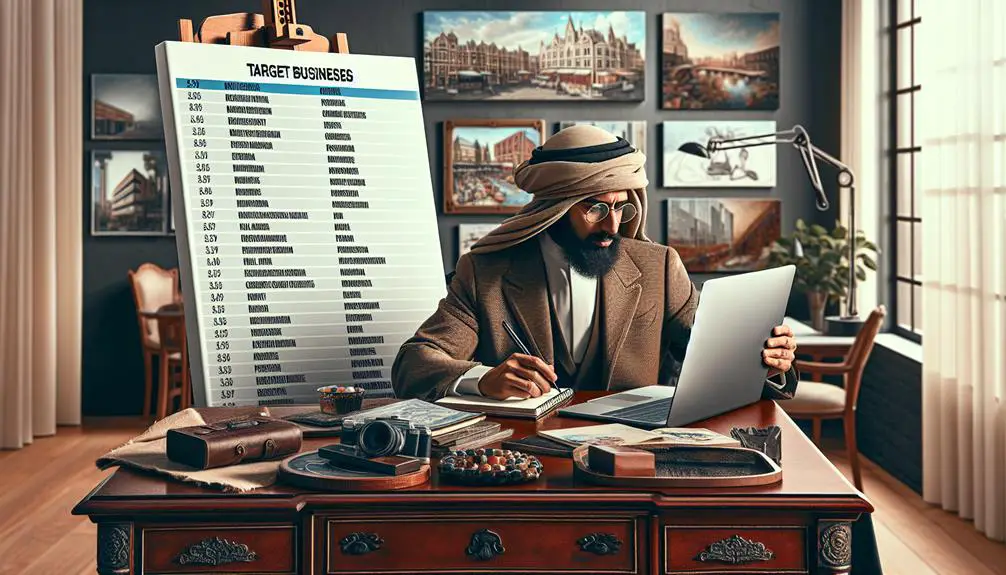
I regularly research and analyze the specific needs and preferences of businesses and hotels in the hospitality industry to effectively target potential buyers for my artwork. By understanding the demands of different businesses and hotels, I can tailor my art to their specific needs, increasing the likelihood of making a successful sale. Here is a table outlining the types of businesses within the hospitality industry that often require art:
| Business Type | Art Requirement | Redecoration Frequency |
|---|---|---|
| Hotels | Large-scale artworks, themed pieces, local art | Every 3-5 years |
| Restaurants | Local art, culinary-themed pieces, vibrant colors | Every 2-3 years |
| Event Venues | Versatile art, large installations, seasonal themes | Yearly |
Understanding the frequency of redecoration within the industry is crucial in targeting businesses and hotels for art sales. Additionally, recognizing the role of contract designers and art consultants in the purchasing process enables me to establish connections with key decision-makers. This proactive approach allows me to stay ahead and align my artwork with the ever-evolving needs of the hospitality industry.
Building Relationships With Decision-Makers

Engaging in networking events and conferences is an effective strategy for establishing connections with decision-makers in the hospitality industry. This allows me to meet key individuals and build relationships that could potentially lead to art procurement opportunities.
Here are some innovative ways I can continue to build relationships with decision-makers:
- Research and Target: I’ll focus on specific design firms and art consultants involved in purchasing artwork for hotels and businesses, allowing me to tailor my approach to potential buyers.
- Utilize Social Media: By leveraging social media platforms and online design forums, I can gain insight into the aesthetic preferences of prospective clients and engage with them in a more personalized manner.
- Create a Professional Portfolio: Developing a professional portfolio that showcases artwork suitable for the hospitality market will enable me to present my work in a compelling and tailored manner.
- Stay in Touch: It’s crucial to maintain communication with consultants and clients, continuously pitching new work to strengthen relationships and maximize sales opportunities.
- Attend Industry Events: Actively participating in industry events and staying updated on the latest trends will allow me to network and stay ahead of the curve in the hospitality art market.
Tailoring Your Art to Fit Business and Hotel Needs
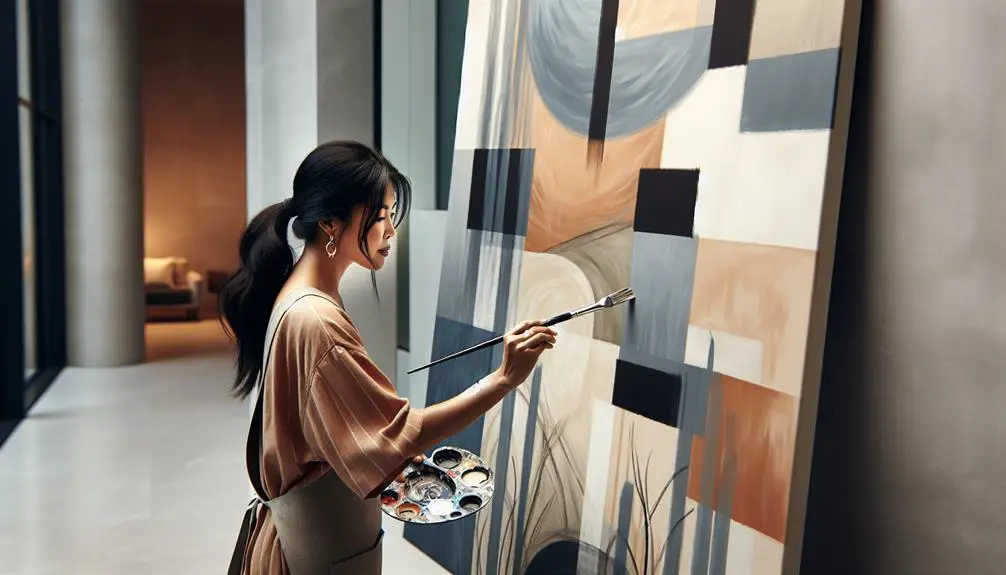
A thorough understanding of the unique requirements and preferences of businesses and hotels is essential when tailoring art for the hospitality industry. It’s crucial to consider the specific needs of this market, such as the durability of materials to withstand heavy foot traffic and the tendency for hotels and restaurants to frequently update their decor. Artwork should also align with the overall aesthetic and branding of the establishment. To better illustrate this, I’ve created a table to highlight key considerations when tailoring art for businesses and hotels:
| Consideration | Explanation |
|---|---|
| Durability | Artwork needs to withstand heavy foot traffic and potential redecorating efforts. |
| Aesthetic Alignment | Art should reflect the branding and ambiance of the business or hotel. |
| Collaboration with Designers | Working with contract designers and art consultants to meet specific requirements and preferences. |
Marketing Your Art to Hotels and Businesses
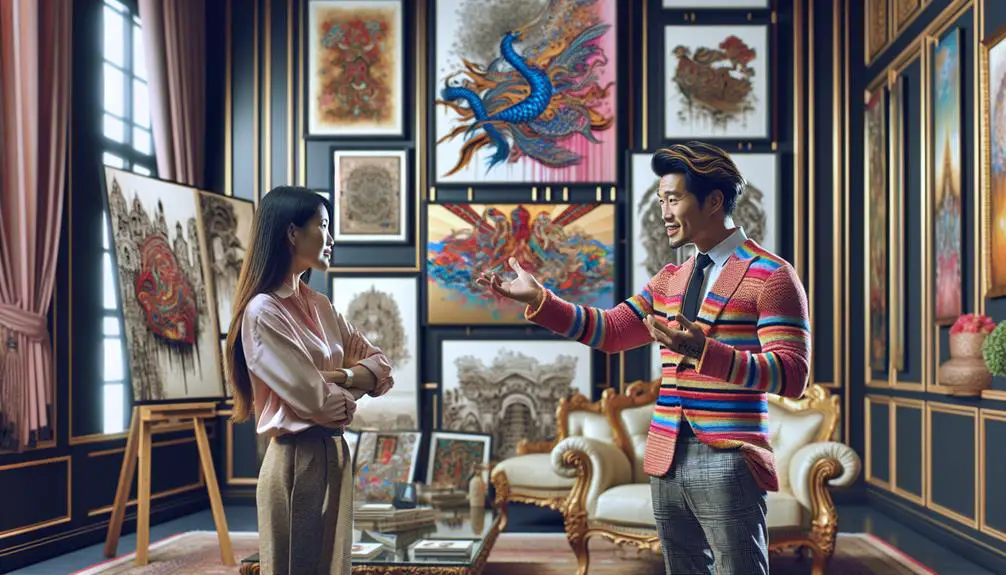
When marketing your art to hotels and businesses, it’s essential to create a highly professional presentation that showcases your artwork in hospitality settings. To effectively market your art to hotels and businesses, consider the following strategies:
- Utilize in situ photos: Display your art in real hospitality settings to help potential buyers visualize how your artwork can enhance their spaces.
- Stay updated on hospitality design trends: Keep your art relevant to the industry by staying informed about the latest trends in hospitality design and incorporating them into your work.
- Network with industry professionals: Attend industry events, follow prospective clients on social media, and join online design forums to connect with potential buyers in the hospitality industry.
- Tailor your website to prospective clients: Gear your website towards hospitality buyers, showcasing your art in hotel and business settings and emphasizing its commercial appeal.
- Explore alternative sales channels: Consider retail artwork, commissions for custom pieces, selling to the corporate market, and licensing artwork for various purposes to diversify your income opportunities.
Leveraging Art Tours and Exhibits
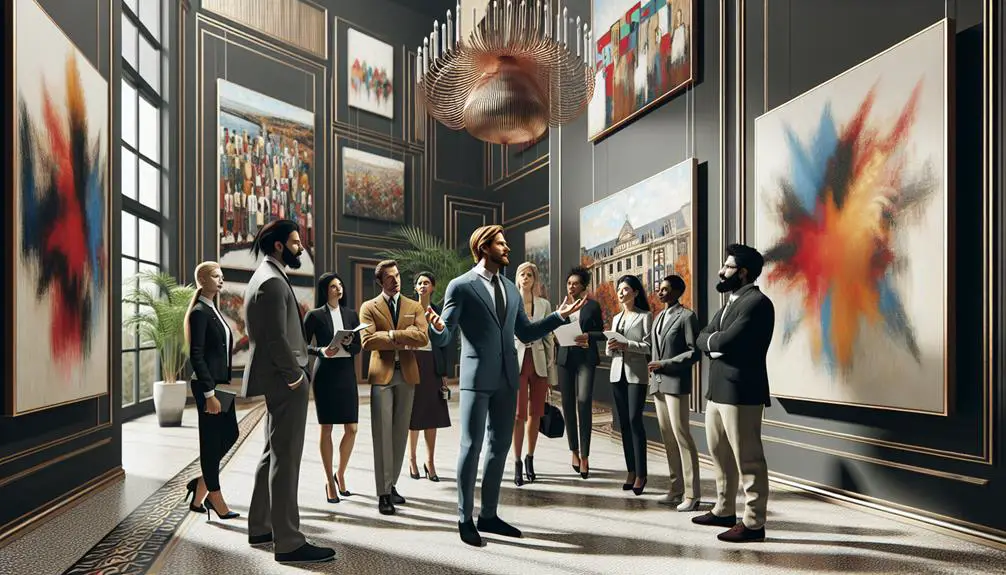
Participating in art tours and exhibits hosted at hotels provides artists with an unparalleled opportunity to showcase their work to a diverse and captive audience. It’s an innovative way to gain visibility and exposure for your art.
Hotels offer unique spaces like lobbies, guest rooms, and restaurants, creating the perfect setting for art exhibitions. This allows artists to connect with potential buyers and a new audience, making a lasting impression on travelers and showcasing their work to a diverse and international clientele.
Hotels often reflect the culture of their area by featuring local artists, aligning the artwork with the hotel’s brand and personality. Leveraging art tours and exhibits in hotels can lead to increased recognition and sales opportunities.
It’s a chance to tap into a market that’s constantly evolving and seeking fresh, unique experiences. By participating in hotel art tours, artists can expand their reach and engage with a captive audience, ultimately enhancing their presence in the art world.
Negotiating Contracts and Agreements

When negotiating contracts and agreements for selling my art to hotels and businesses, I focus on understanding the terms thoroughly and being clear about pricing, deliverables, and deadlines. Seeking legal advice or professional consultation before finalizing any agreements is crucial to ensure that my rights and interests are protected.
I also make sure to negotiate for fair compensation and have all details regarding exclusivity and reproduction rights explicitly stated in the contract.
Contract Terms Negotiation
Negotiating contract terms with hospitality clients requires a thorough understanding of the terms and conditions, including exclusivity, reproduction rights, and licensing fees, to ensure fair compensation and protection of your artwork.
When engaging in contract terms negotiation with hotels and businesses, consider the following:
- Clarify usage rights for your artwork, ensuring that terms like exclusivity and reproduction rights are clearly defined.
- Discuss payment terms, such as upfront fees, royalties, and payment schedules, to establish fair compensation for your art.
- Consider the duration of the contract, renewal options, and termination clauses to protect your interests and allow for flexibility.
- Seek legal advice or professional guidance to ensure that the contract terms are favorable and provide adequate protection for your work.
- Aim for a balance that benefits both parties and fosters a collaborative and innovative partnership.
Pricing and Payment
Navigating through the negotiation of contract terms with hospitality clients, I’ve learned the importance of setting fair pricing terms and establishing a secure payment structure when selling art to hotels and businesses. Understanding the commercial value of my artwork and being open to negotiating based on size, quantity, and exclusivity has been pivotal.
Clearly outlining payment terms, timelines, and invoicing procedures in the contract has proven crucial to protect both parties’ interests and prevent misunderstandings. Offering flexible payment options, such as installment plans or bulk discounts, has enabled me to accommodate the diverse budgets and preferences of hotel and business buyers.
Seeking legal advice or professional guidance has been essential to ensure that contracts and agreements adhere to industry standards and safeguard my rights as an artist. This approach fosters a transparent and mutually beneficial relationship with clients seeking innovative art for their establishments.
Legal Considerations
Understanding the legal aspects related to negotiating contracts and agreements is essential when selling art to hotels and businesses. When it comes to legal considerations, here are some key points to keep in mind:
- Consider seeking legal advice to ensure your contracts protect your rights and interests as an artist.
- Negotiate terms and conditions that safeguard your intellectual property, licensing rights, and payment terms.
- Be clear and specific about the scope of usage, reproduction rights, and exclusivity in your contractual agreements.
- Ensure that your contracts address issues such as copyright, royalties, indemnification, and termination clauses to protect your artwork and your business.
It’s crucial to have a solid understanding of the legal implications involved in selling your art to businesses, and ensuring your contracts are comprehensive and protective is vital for your success in this innovative industry.
Showcasing Your Art in Public Spaces
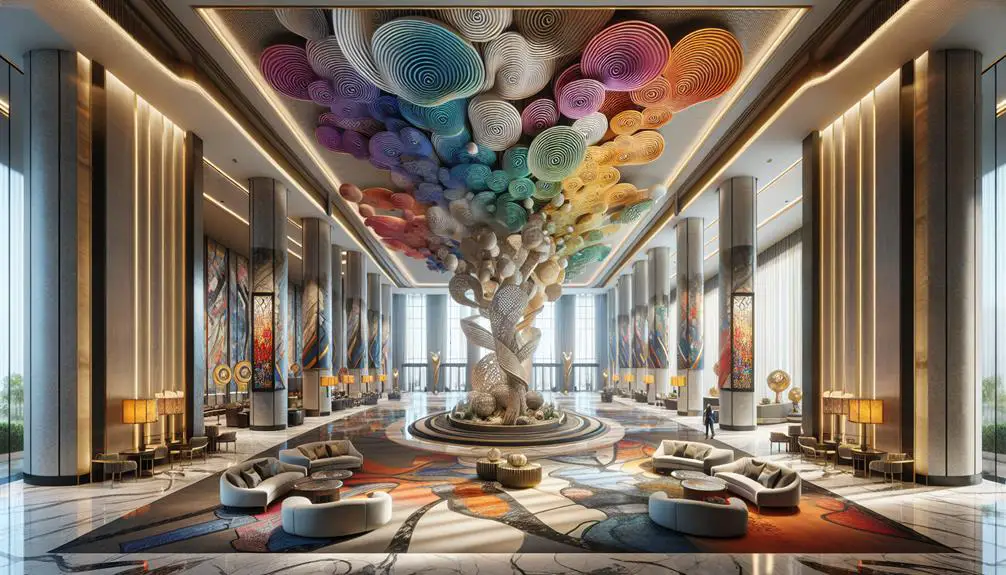
When showcasing your art in public spaces, it’s essential to consider art placement strategies that complement the environment and engage viewers.
Selecting suitable art that resonates with the hotel or business’s brand and target audience is crucial for making a lasting impact.
Additionally, marketing your art effectively through online platforms and networking opportunities can help increase visibility and attract potential buyers.
Art Placement Strategies
In showcasing your art in public spaces, it’s essential to consider the durability and visual appeal of the pieces within the context of heavy foot traffic and frequent redecoration cycles. To ensure effective art placement, I suggest the following strategies:
- Embrace versatility: Create art that can be easily moved and repositioned to accommodate changing decor schemes.
- Focus on impact: Opt for bold, attention-grabbing pieces that can stand out in high-traffic areas.
- Consider scale and proportion: Tailor the size of your artwork to complement the specific architecture and design of the space.
- Collaborate with designers: Engage with interior designers and art consultants to understand the aesthetic and thematic needs of the space.
- Incorporate interactive elements: Integrate technology or interactive components into your art to captivate and engage viewers in new and innovative ways.
Selecting Suitable Art
Embracing the need for durable and visually impactful art placement strategies sets the stage for the discussion on selecting suitable art to showcase in public spaces, particularly in the hospitality industry. In this dynamic landscape, it’s crucial to consider the heavy foot traffic and the constant redecoration cycles of hotels and restaurants.
Artists should be open to creating reproductions and prints, as these are common in the hospitality industry and can lead to additional income through licensing fees. To connect with potential buyers, utilizing online design forums and specialized portals for networking is essential.
Moreover, staying informed about trends in hospitality design is key to ensuring that your artwork aligns with the market’s needs and preferences. By staying agile and innovative, artists can effectively position their work for success in this vibrant industry.
Marketing Your Art
To effectively market your art for public spaces, it’s essential to understand the specific needs and preferences of the hospitality industry. Here are some key strategies that can help you effectively market your art for public spaces:
- Understand the diverse businesses, need for durable art, and frequent redecoration cycles within the hospitality industry.
- Explore the common need for reproductions, large quantities of art, and the potential for licensing fees and trends awareness.
- Engage with trade journals, industry events, and online design forums, and create a professional portfolio to reach hospitality buyers.
- Ensure professionalism, in situ photos, industry-focused websites, understanding client needs, and following up for successful sales.
- Consider retail, commissions, corporate sales, licensing, and additional income opportunities in the hospitality industry.
Conclusion
As I navigate the world of selling art to hotels and businesses, I’ve learned that it’s like planting a seed and watching it grow into a beautiful garden.
By understanding the market, cultivating relationships, and showcasing my art in the right spaces, I’m able to see my creativity bloom and flourish.
Just like a garden needs care and attention, so does my artwork in order to thrive in the hospitality and corporate world.


